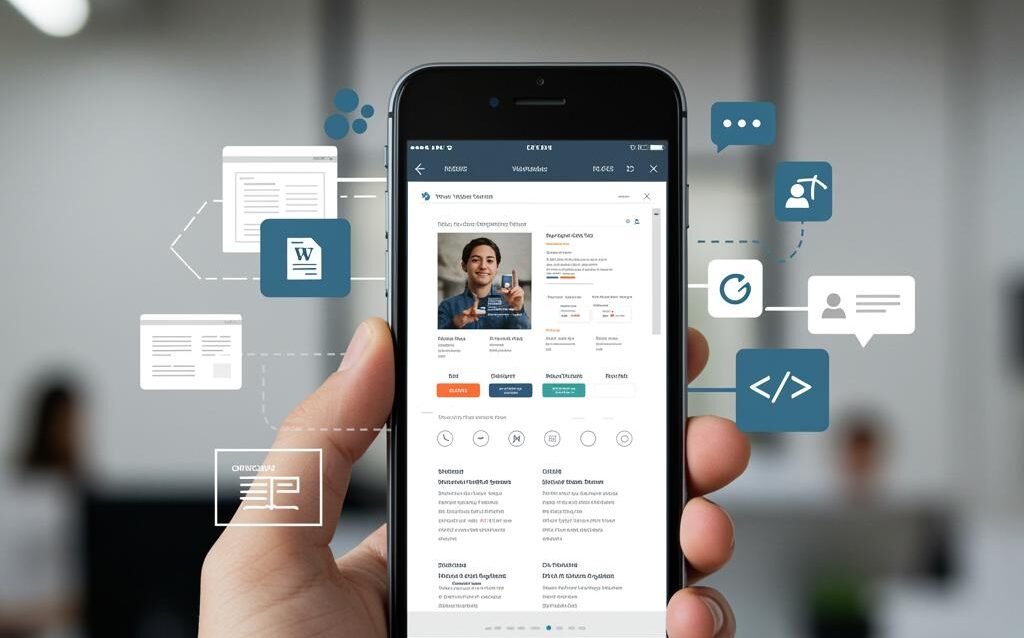Mobile-First WordPress: Beyond Responsive Design Best Practices
Mobile-First WordPress Design: Best Practices Beyond Responsive Themes
In today’s digital landscape, mobile devices reign supreme. More users are accessing the internet via smartphones and tablets than ever before, making a mobile-first approach to website design absolutely crucial. While responsive themes are a good starting point, truly embracing mobile-first design in WordPress requires going beyond simply adapting your desktop site to smaller screens. It’s about prioritizing the mobile experience from the very beginning.
Understanding Mobile-First Philosophy
Why Mobile-First Matters
The mobile-first philosophy advocates for designing and developing your website with the smallest screen in mind first. This approach forces you to prioritize content, optimize performance, and create a streamlined user experience. It’s not just about making your site look good on mobile; it’s about making it function exceptionally well. Benefits include improved page speed, better SEO rankings (Google prioritizes mobile-friendly sites), and enhanced user engagement.
Beyond Responsiveness: A Different Mindset
Responsive design adapts a desktop-first site to mobile. Mobile-first starts with mobile as the core experience. This difference in approach leads to fundamental changes in design decisions. Instead of squeezing elements onto smaller screens, you start by asking: “What is the most essential content and functionality for mobile users?” This question shapes your entire design process.
Optimizing Content for Mobile Users
Prioritizing Content and Information Architecture
Mobile users have limited screen real estate and often shorter attention spans. Therefore, prioritizing content is paramount. Start by identifying the key information and calls to action that mobile users need. Consider:
- Clear Headlines: Use concise and descriptive headlines that immediately convey the page’s purpose.
- Concise Paragraphs: Break up large blocks of text into shorter, more digestible paragraphs.
- Bullet Points and Lists: Utilize bullet points and numbered lists to present information in a scannable format.
- Strategic Use of Whitespace: Adequate whitespace improves readability and reduces visual clutter.
Mobile-Friendly Typography
Choosing the right fonts and font sizes is critical for readability on smaller screens. Consider these factors:
- Legible Font Families: Opt for clear and easy-to-read font families like sans-serif fonts.
- Adequate Font Size: Ensure that text is large enough to be easily read without zooming. A minimum font size of 16px is generally recommended.
- Line Height and Letter Spacing: Adjust line height and letter spacing to improve readability and prevent text from feeling cramped.
Performance Optimization for Mobile
Image Optimization
Large, unoptimized images are a major performance bottleneck on mobile devices. Implement these techniques:
- Compress Images: Use image compression tools to reduce file sizes without sacrificing too much quality.
- Choose the Right Image Format: Use WebP for superior compression and quality, or JPEG for photos and PNG for graphics.
- Responsive Images: Serve different image sizes based on the user’s screen size using the
srcsetattribute in the<img>tag. - Lazy Loading: Load images only when they are visible in the viewport.
Minifying CSS and JavaScript
Minifying CSS and JavaScript files removes unnecessary characters (whitespace, comments) to reduce file sizes. This can significantly improve page load times.
- Use a Plugin: Several WordPress plugins can automatically minify CSS and JavaScript files.
- Consider CDN: A Content Delivery Network (CDN) can distribute your website’s assets across multiple servers, improving loading speeds for users around the world.
Leveraging Browser Caching
Browser caching allows browsers to store static assets (images, CSS, JavaScript) locally, so they don’t have to be downloaded again on subsequent visits. This can dramatically speed up page load times.
Mobile-Friendly Navigation and User Experience
Simplified Navigation Menus
Complex desktop navigation menus are often cumbersome to use on mobile devices. Simplify your navigation by:
- Using a Hamburger Menu: The hamburger menu (three horizontal lines) is a common and recognizable mobile navigation pattern.
- Prioritizing Key Pages: Focus on the most important pages and limit the number of menu items.
- Clear and Concise Labels: Use short and descriptive labels for menu items.
Touch-Friendly Design
Mobile users interact with websites using their fingers, so it’s crucial to design with touch in mind. Consider these guidelines:
- Large Touch Targets: Ensure that buttons and links are large enough to be easily tapped without accidentally selecting the wrong element.
- Adequate Spacing: Provide enough spacing between touch targets to prevent accidental taps.
- Avoid Hover Effects: Hover effects are not applicable on touch devices, so avoid relying on them for important functionality.
Testing and Iteration
Mobile Testing Tools
Regularly test your website on a variety of mobile devices and screen sizes to ensure a consistent and optimal user experience. Use tools like:
- Google’s Mobile-Friendly Test: This tool checks if your website is mobile-friendly according to Google’s standards.
- Browser Developer Tools: Most browsers have built-in developer tools that allow you to emulate different mobile devices.
- Real Device Testing: Whenever possible, test your website on real mobile devices to get a true sense of the user experience.
User Feedback and Analytics
Gather user feedback through surveys, polls, and user testing to identify areas for improvement. Analyze website analytics to track mobile traffic, bounce rates, and conversion rates to gain insights into user behavior.
Conclusion
Adopting a mobile-first approach to WordPress design is no longer optional; it’s essential for success. By prioritizing mobile users, optimizing content and performance, and creating a touch-friendly user experience, you can create a website that engages and converts visitors on any device. Remember that mobile-first is an ongoing process of testing, iteration, and improvement. By continuously refining your mobile strategy, you can stay ahead of the curve and deliver a superior user experience to your mobile audience.

